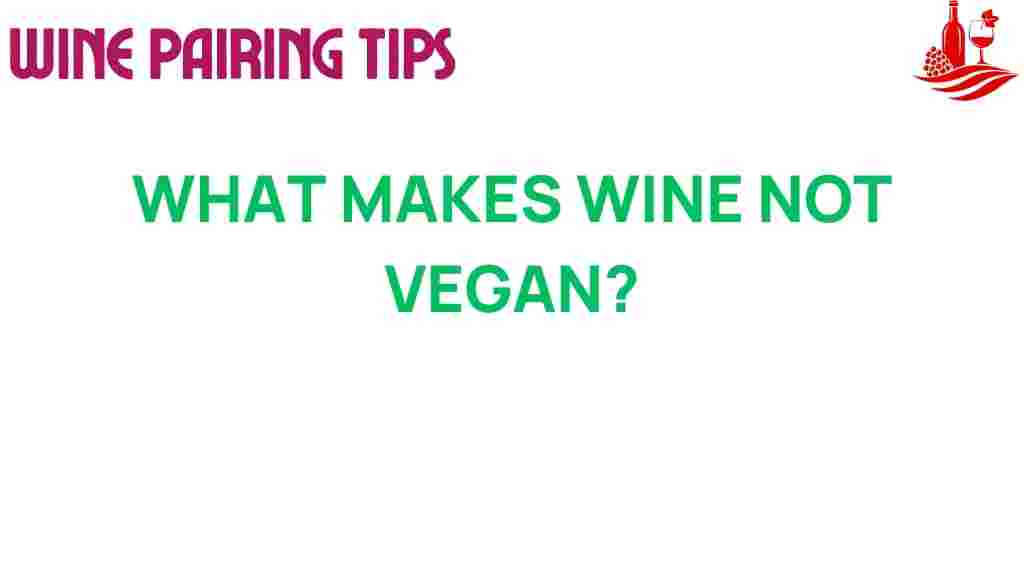Unveiling the Secrets: What Makes Wine Not Vegan?
When it comes to making ethical choices, many individuals are increasingly concerned about the food and beverages they consume. One area that often surprises wine lovers is the question of whether wine is vegan. The answer is more complex than many might think, as certain production processes can involve animal byproducts. This article will delve into the details of vegan wine, the use of fining agents, and how these factors intertwine with sustainable practices and organic wine production.
The Wine Production Process
To understand why some wines are not vegan, it’s essential to first grasp the wine production process. Wine making involves several stages, including fermentation, aging, and bottling. Each stage can potentially introduce non-vegan elements, particularly through the use of fining agents.
What Are Fining Agents?
Fining agents are substances used in the wine production process to clarify and stabilize the wine. They help remove unwanted particles, improve the texture, and enhance the appearance of the wine. Common fining agents include:
- Gelatin: Derived from animal collagen, gelatin is one of the most common fining agents.
- Isinglass: Made from fish bladders, isinglass is often used in the fining process.
- Casein: A milk protein, casein can be used to clarify wine.
- Albumin: Egg whites are used to fine and clarify certain red wines.
- Bentonite: A clay mineral that is often vegan and used for fining, but not all wines use it.
As you can see, many traditional fining agents are derived from animals, which disqualifies those wines from being labeled as vegan. Thus, the presence of these animal byproducts significantly impacts the vegan status of certain wines.
Identifying Vegan Wine
So, how can you identify a vegan wine? The key lies in understanding wine labels and doing a bit of research. Here’s how you can navigate through wine options while keeping your ethical choices in mind:
1. Check the Wine Label
While many wine labels don’t explicitly state whether the wine is vegan, some producers are now making it a point to label their wines accordingly. Look for terms like:
- Vegan-friendly: This label indicates that no animal-derived fining agents were used in the production.
- Unfined and unfiltered: Wines with this label typically do not use any fining agents.
- Organic wine: While not all organic wines are vegan, many producers use sustainable practices that avoid animal byproducts.
2. Research the Winery
Many wineries have websites that provide detailed information about their production methods. Look for sections on sustainability or ethics, where they might discuss their fining processes. If the information isn’t available, consider reaching out to the winery directly.
3. Use Apps and Resources
There are several apps and online databases designed to help consumers find vegan wine. These resources can provide information about various brands and their production methods. One popular resource is Barnivore, which specializes in vegan alcohol listings.
Understanding the Wine Industry’s Shift Towards Vegan Options
As consumer demand for ethical choices increases, many wineries are adapting their practices. The wine industry is witnessing a significant shift towards more sustainable and vegan-friendly methods. Here’s how:
1. Adoption of Plant-Based Fining Agents
Some wineries have begun to explore alternatives to traditional animal-derived fining agents. These include:
- Activated charcoal: Used for its filtering properties.
- Pea protein: An emerging alternative that is effective and vegan-friendly.
2. Transparency in Production
More wineries are emphasizing transparency in their production processes. This openness allows consumers to make informed choices about their wine, ensuring they align with personal values regarding sustainable practices and veganism.
3. Organic and Biodynamic Practices
The rise of organic and biodynamic wines has also contributed to the vegan wine movement. Many organic wine producers avoid using animal byproducts altogether, opting for natural processes that prioritize the health of the vineyard ecosystem.
Troubleshooting Tips for Finding Vegan Wine
Despite the growing availability of vegan wine, you may still encounter challenges when searching for it. Here are some troubleshooting tips:
1. Don’t Hesitate to Ask
If you’re at a restaurant or a wine shop and can’t find vegan options, don’t hesitate to ask the staff. They may have insights or recommendations.
2. Read Online Reviews
Look for blogs and reviews that focus on vegan wine. Many wine enthusiasts share their experiences and can point you to great vegan-friendly options.
3. Attend Vegan Wine Tastings
Some events focus specifically on vegan wines, providing a unique opportunity to taste and learn more about these options. Check local listings or vegan community boards for upcoming events.
The Benefits of Choosing Vegan Wine
Choosing vegan wine not only supports your ethical choices but can also align with broader concerns about health and sustainability. Here are a few benefits of opting for vegan wines:
- Better for the Environment: Many vegan wines are produced using sustainable practices that minimize environmental impact.
- Healthier for You: Vegan wines often avoid the use of animal byproducts, which can be beneficial for those with dietary restrictions or allergies.
- Support Ethical Practices: By choosing vegan wine, you support wineries that prioritize ethical and sustainable production methods.
Conclusion
In summary, the question of whether wine is vegan hinges largely on the use of fining agents and the production methods employed by the winery. By becoming more aware of wine labels, researching producers, and utilizing reliable vegan wine resources, you can make informed choices that align with your values. As the wine industry continues to evolve towards more sustainable and ethical practices, the availability of vegan wine will likely increase, allowing everyone to enjoy their favorite beverage without compromising their principles. For more information on vegan wine options, visit this resource.
This article is in the category Tips and created by Wine Pairing Tips Team
